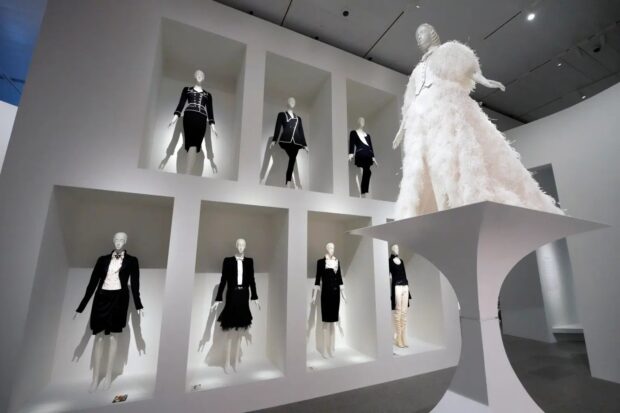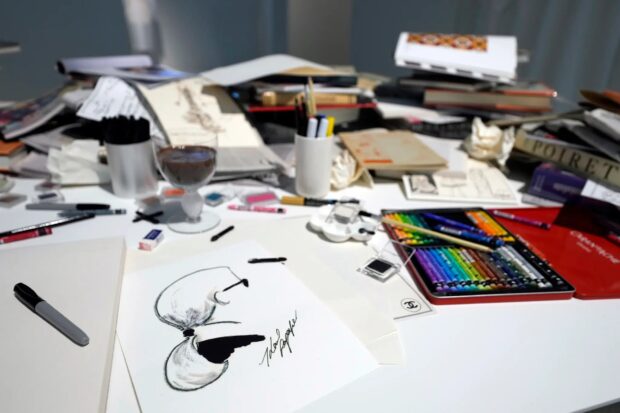Karl Lagerfeld is considered a luminary in the fashion world, having made a name for himself through his early designs with Balmain, Patou, Chloé, and Fendi, as well as his collaborations with streetwear. When he stood at the helm of Chanel, he cemented his place in fashion history and later went on to establish his own eponymous label.
Four years after his death, Vogue Editor-in-Chief Anna Wintour selected the theme “Karl Lagerfeld: A Line of Beauty” for the 2023 Met Gala’s spring costume exhibition. While a large portion of the spotlight typically shines on celebrity outfit ensembles, this year, many of Lagerfeld’s previous problematic statements overshadowed the exhibit in question.
A few weeks earlier, the high fashion Met Gala coverage team announced on Twitter that they wouldn’t be sharing the event this year because “their values don’t align with the selection of Karl Lagerfeld as the theme.”


For some, Lagerfeld represents all the toxic traits the fashion industry has been trying to rise above in recent years. The German-born designer was opinionated and unapologetic throughout his life, often throwing fatphobic, racist, and misogynistic quips. We go on a walk-through of the controversial history of Karl Lagerfeld in his 65-year career, documenting his sharp tongue, often sans filter.
A History of Body Shaming
Perhaps one of the reasons Lagerfeld has been most criticized is his comments on body shaming. The fashion world has been trying to become more inclusive, welcoming fashion models with larger bodies. Yet Lagerfeld has been relentless. In a 2009 interview, he defended his preference for size 0 women, telling the German magazine Focus that “no one wants to see curvy women.” He went on to say, “You’ve got fat mothers with their bags of chips sitting in front of the television and saying that thin models are ugly. The world of beautiful clothing is about ‘dreams and illusions.’” Lagerfeld never hesitated to criticize celebrities, calling both Adele and Lana Del Rey “a little too fat.”

It didn’t stop there. In 2013, he went so far as to blame societal woes on “all the diseases caught by people who are too fat.” The statement prompted the French organization Belle, Ronde, Sexy et je m’assume (Beautiful, Round, Sexy and Ok with it) to take legal action against the designer.
Undermining the #MeTooMovement
On the #MeTooMovement Lagerfeld glibly stated, “I’m fed up with it,” in an interview with Numéro magazine. When stylist Karl Temper was accused of sexual harassment by multiple models, Lagerfeld went so far as to defend him, going on to say, “It’s simply too much; from now on, as a designer, you can’t do anything!” He exclaimed in the interview, “It’s unbelievable—if you don’t want your pants pulled about, don’t become a model! Join a nunnery. There’ll always be a place for you in the convent.”
Racist Comments
In 2017, Lagerfeld sparked serious controversy when he made comments about German Chancellor Angela Merkel’s open-door policy toward refugees. A migrant himself, he called these refugees enemies of Jews, “One cannot – even if there are decades between them – kill millions of Jews so you can bring millions of their worst enemies in their place.” He went on to add, “I know someone in Germany who took a young Syrian and after four days said: ‘The greatest thing Germany invented was the Holocaust’”.
“Everything I say is a joke,” Lagerfeld once claimed. But from real fur use that piqued animal rights activists, to the culturally-inappropriate use of Native American headdresses in a Chanel show in 2015, the list of problematic choices made by the designer goes on. In 2010, Lagerfeld mounted a 28-foot-high iceberg for a ready-to-wear show. The presentation scraped the ice from a massive glacier in Sweden, ultimately failing to make an intended comment on global warming by severely contributing to it.
In 1994, supermodel Claudia Schiffer sashayed down the runway in a Chanel dress embroidered with sacred Muslim text. The dress sparked worldwide controversy. For once, he issued a rare apology on behalf of the fashion house.
Jameela Jamil, star of the TV series, “The Good Place” took to Instagram to acknowledge the talent of Lagerfeld, but also address the “distinctly hateful” speech, “mostly towards women, so repeatedly… showing no remorse.”
Writer Emily Kirkpatrick manages a newsletter “I <3 Mess,” which has often covered the many controversies of Karl Lagerfeld. While she lauds his legacy, she cites the importance of remembering his often “ugly reality.” She says:
“Fashion doesn’t care at the end of the day, fashion has never cared… It’s easier for us to consume pretty things without reckoning with the horrible story behind them.”
Lagerfeld left deep contributions to fashion that revolutionized the aesthetic tastes of each decade—yet notably, the designer never chose to adapt to the same attitude of society in the changing times.

